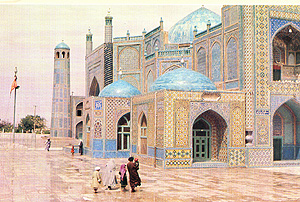Find Out All About Historic Balkh

Balkh is one of the thirty-four provinces of Afghanistan. It is in the north of the country. Its capital is Mazar-e Sharif. Although today only a small provincial town, Balkh speaks of greatness in Afghanistan's history. As Bakhtri it was the birthplace of the prophet Zoroaster and as Bactria it was conquered by Alexander the Great in 329BC and was the city where he took his wife Roxanne. Bactria thrived under Kushan Buddhist rule as a centre of the silk routes, before it's cultural flourishing with the advent of Islam. The Arabs called Balkh the "Mother of Cities" and the city became one of the great intellectual centres of early Islam, in part due to its Hellenic roots. Two of the greatest of all Persian poets were born in the city- the Lady Rabi'a in the 10th century, and Jalaluddin Rumi two hundred years ago. Rumi is also known as the Sufi master Mevlana in Turkey - the country to where his family fled in advance of the Mongol invasions of 1220-1221. Balkh never truly recovered from the depredations of Genghis Khan. Marco Polo passed through its ruins 50 years later, as did Ibn Battuta in 1333 remarked on Balkh as a "ruin without society", it has been destroyed so completely. Despite a brief renaissance in the 15th century under the Timurids, Balkh was subsequently overshadowed by the expansion of nearby Mazar-e Sharif. Balkh lies 20km west of Mazar-e Sharif, and is notable for two of Afghanistan's most important medieval Islamic sites. There are a few chaikhanas in the town, which is most easily visited as a day trip from Mazar. There are few outstanding security issues in Balkh beyond the advice given for Mazar, although it should be noticed that in 2005, opium production expanded greatly in Balkh province, where it had previously been little grown. No-Gombad Mosque Shrine of Khwaja Abu Nasr Parsa Ancient Balkh
Based on an unusual nine dome (no gumbad) colonnaded plan, this mosque, also known as the Haji Piyada Mosque is the oldest Islamic monuments in Afghanistan, dating from the 9th century. Just 10m square, the domes have long fallen and the floor is buried in rubble. The columns and capitals are particularly notable however, with their carved stucco possibly influenced by Samarra in Iraq. The mosque is covered with a protective metal roof and has underwent limited conservation work supported by the Society for the Preservation of Afghanistan's Cultural Heritage in 1999 and 2001. It stands just south of the town's limits, surrounded by fields of marijuana.
The shrine of Khwaja Abu Nasr Parsa was built for an eminent theologian in 1460-1461 and is a model of Timurid architecture. The building is octagonal, with a monumental flanked by twisted cable-moulded columns and two minarets, and topped by a fluted blue dome. Although badly deteriorated, the shrine still has an awesome effect.The mosque is located in Balkh's central park.
The ruins of ancient Balkh lie on the mainly on the north side of the town, and are unmissable in their scale. The vast and eroded city walls are Timurid, but have never been properly excavated and certainly lie on the ruins of the older city, possibly back a further thousand years to the Kushan period. Several towers still stand, interspersed with fields and the mud-brick houses of locals. Illegal excavations continue around the old walls.
Other cities include: Balkh The districts of Balkh are:
| Balkh |
| Charbolak |
| Char Kent |
| Chimtal |
| Dawlatabad |
| Dehdadi |
| Kaldar |
| Khulm |
| Kishindeh |
| Mazar-i Sharif |
| Marmul |
| Nahr-i Shahi |
| Sholgara |
| Shortepa |
Hazrat Ali Shrine, Rawza-e Mubarak
Shrine of Hazrat Ali A history of the tomb was rediscovered during the reign of the Timurid Sheikh Sultan Baiqara, who commissioned a new shrine in 1481. Much restored, this shrine still forms the centre of modern Mazar. Set in a large courtyard, the Shrine of Hazrat Ali is a rhapsody of blue mosaic tiling, with a main south-facing portal leading to the tomb itself, supplanted by twin domes. Little of the original Timurid building remains, due to constant rebuilding and renovation throughout its history; most of the tiling is mid-20th Century from the tile workshop of the Herat Friday Mosque. The condition of the shrine is excellent, making it one of Afghanistan's best preserved monuments. Within the complex and west of the shrine is the tomb of Amir Sher Ali, Dost Mohammed's son and successor. Another of Dost Mohammed's sons, Wazir Akbar Khan is buried south of the shrine. The shrine courtyard is home to hundreds of white pigeons. Local tradition recounts that one in seven is a spirit, and that any grey pigeons in the flock will turn white in forty days due to the holiness of the area. The courtyard of the shrine is also the focus of Mazar's Nauroz celebrations. On March 21 a huge religious banner (janda) is raised and flown for forty days to celebrate the coming of spring, marked by buzkashi games and the Gul Surkh festival. At the end of the forty days, the Janda is lowered, and the festival of Gul Surkh ('Red Blossom') is celebrated, as red tulips blossom around Mazar, associated with prosperity and fertility. Entrance to the tomb is forbidden to non-Muslims. Some visitors have also been asked to pay a 'camera fee', although it is unclear if genuine or a demand for an extra tip at the gate. | |

